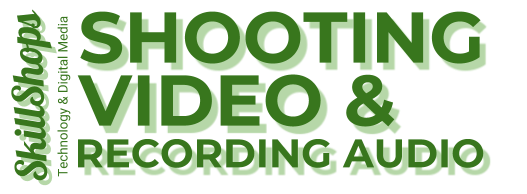shootingVideo
Shooting Video & Recording Audio is a 50-minute workshop and handout to teach and learn how to plan out a video project by Jesse Garcia.

Shooting Video & Recording Audio
DSLRs, Camcorders, Mics and more!
Whos is this guide for? Students!
This is a guide to help you get started with creating a short video for class projects, uploading to social media and sharing with the rest of the world.
Shoot your video with the help of the Digital Media Lab. You can check out cameras, microphones tripods and other accessories that you will need for your project.
Software to edit this footage is available at the media lab. There’s also online sites students can download free audio for their projects. See below for more info.
Storyboard
Fill out the storyboard with what you want to record in your scene. How will you frame the shot? Who will be in the shot? What kind of audio will you need to capture (voice, background sounds, background music)?

When planning your video project, you will want to think about:
- Equipment (camera, mic, props)
- Environment (location, lighting, noise, traffic)
- Footage (B-roll, where, what equipment, types of shots)
Framing & Quick Tips:
Portrait framing
Use the Rule of Thirds is to place your subject in the frame asymmetrically. Picture lines in your frame breaking up the scene into three parts vertically and horizontally (nine sections in total). Place your subjects on the intersecting lines. For example:

B-roll Shots
B-roll is alternative footage that you can use to supplement your main footage. B-roll is useful when you need extra footage and sound and is a good way to give a sense of scenery to your viewers or audience. Start your shots early and take extra shots or shoot your surroundings to gather B-roll footage.
Be Prepared
Have an extra battery or a plan for charging your camera and/or audio recorder.
Be sure to have enough space on the SD card or have a plan to offload your footage to a hard drive or computer between shoots.
Lastly, have a backup for audio. Use the camera or lavalier mic, but also record using a digital recorder or smartphone just in case something goes awry.
Other useful links and resources:
Editing software:
- HSU Campus: Camtasia is installed on campus.
- Mac: iMovie
- Windows: Story Remix
- Web-based: Adobe Spark (free with watermark at the end)
- Phone Apps:
- GoPro Splice (iOS)
- Adobe Spark (iOS, Android coming soon)
Free Music available
Camtasia Tutorials
- https://www.techsmith.com/tutorial-camtasia.html
- Online SkillShop - Getting Started with Camtasia
Digital Media Lab
- http://libguides.humboldt.edu/dml
- Email dml@humboldt.edu for project consultations, equipment orientations or anything else!
Access Humboldt Info
- Access Humboldt is a non-profit, community media organization serving the residents of Humboldt County. They offer workshops, studio space and equipment for rent.
For more info visit: http://libguides.humboldt.edu/dml or email dml@humboldt.edu
This guide has an open Creative Commons license. You can use, share, remix and repurpose this content as long as you attribute the author, Jesse Garcia CC BY, 2018. If you’re re-using this guide, we’d love to hear about your project- dml@humboldt.edu.